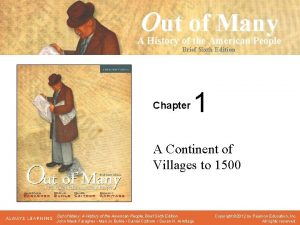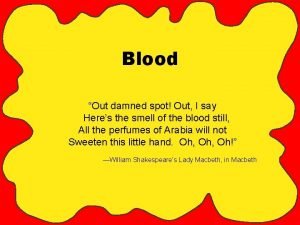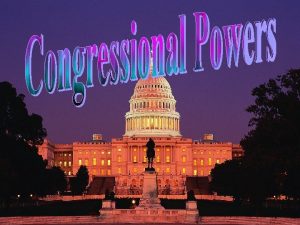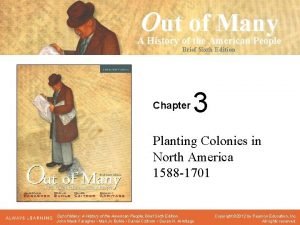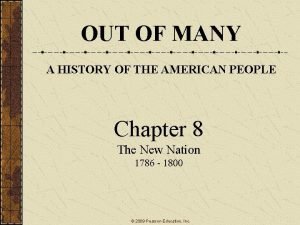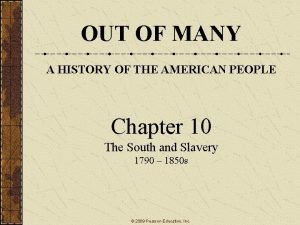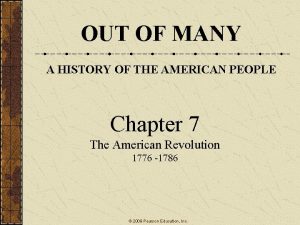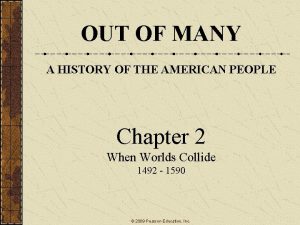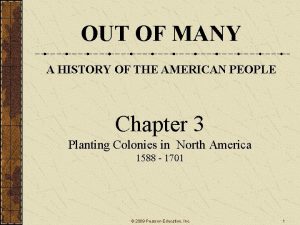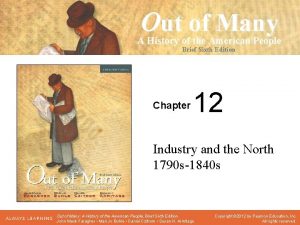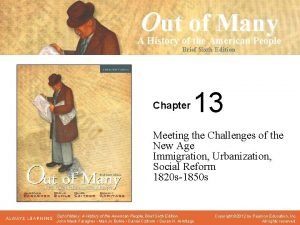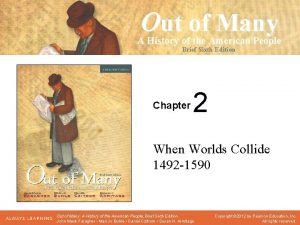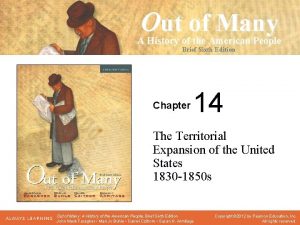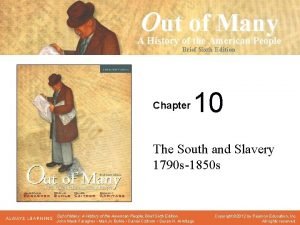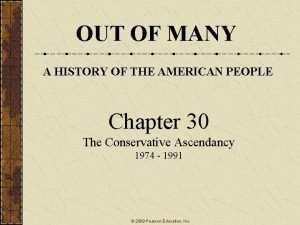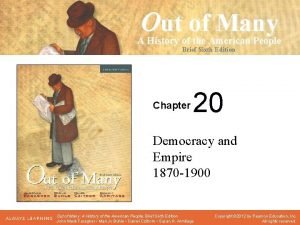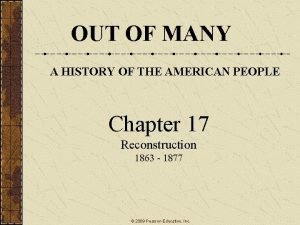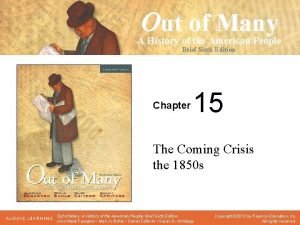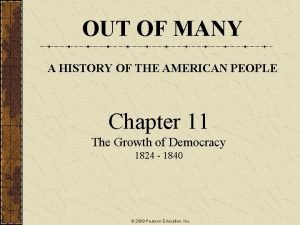OUT OF MANY A HISTORY OF THE AMERICAN




































































- Slides: 68

OUT OF MANY A HISTORY OF THE AMERICAN PEOPLE Chapter 10 The South and Slavery 1790 – 1850 s © 2009 Pearson Education, Inc.

Part One: Introduction © 2009 Pearson Education, Inc. 2

Essential Questions How did cotton production after 1793 transform the social and political history of the South? How did the rest of the nation benefit? How did this have an international link? © 2009 Pearson Education, Inc. 3

AP Themes American Diversity: Division by race Legal and social laws to keep slaves in their “place” Culture: African Americans created their own culture to survive Keep their identity - African & Caribbean roots Support one another & create extended family when friends, husbands, parents are sold or die Songs, religion, language

AP Themes Economic Difference between North and South increases Dependence on cotton as its cash crop Lack of industrialization Reliance on the demand for cotton - could change and not reliable Environment Depletion of soil nutrients forces movement west to better lands - slavery moves West Slavery Legacy Whites see slave as lazy or incompetent Slaves work slow and destroy tools on purpose to resist

Antebellum or Pre-War South Industrial Revolution brings textile factoreis to England – demand for cotton rises South dependent on cotton as King crop Dependent on slavery – only slaves would do the work on the plantation (their thoughts) Plantation system - wealth and political clout of the South Cotton tied to national and international markets threat Lack of change or growth

Cotton as King Tobacco prices decline Cotton gin increases the profitability of cotton - 1 man went from taking seeds out of 1 pound of cotton to 50 pounds in a day Demand grew for cotton from 500, 000 in 1820 5 Million in 1850 North uses it in textile factories, insures it, finances it Cotton was the USA’s Major Export -60%

Economic and Social Affect Increase in slavery and slave migration from sale of slaves from upper South to new Southwest Keep slaves under firm control Master and slave Model of race relations and relations of husband wife Did not industrialize by choice © 2009 Pearson Education, Inc. 8

South and North grows through industry South rejects the idea Fewer railroads and canals Did not want free labor and factories Cotton was easier Population growing in North so more representatives in Congress © 2009 Pearson Education, Inc. 9

Political fears South population not growing Fear of fewer slaves states Fear of people being against slavery – abolitionists In House of Representatives 1830 - gag rule – not allowed to present any abolitionist laws or discussion before the ahoue 4 © 2009 Pearson Education, Inc. 10

Northern reliance on the South Cotton textile mills Northern Banks finance the South Lack of industrialization and economic diversity in the South Wealthy enjoyed their plantation life styles Profits from cotton made many Southern millionaires

Part Three: King Cotton and Southern Expansion © 2009 Pearson Education, Inc. 12

Cotton and Expansion into the Old Southwest Map: The South Expands, 1790 -1850 Eli Whitney’s and Catherine Greene’s cotton gin made cultivating short-staple cotton profitable, revolutionizing the Southern economy. (1793) After the War of 1812 Southerners expanded into Western Georgia, Alabama and Mississippi, driving out the Indians who already lived there, A generation later they poured into Louisiana and Texas. Each surge of expansion ignited a speculative frenzy. The expansion of cotton was concentrated in the rich soil sections of the South known as the black belt. © 2009 Pearson Education, Inc. 13

MAP 10. 1 The South Expands, 1790– 1850 This map shows the dramatic effect cotton production had on southern expansion. From the original six states of 1790, westward expansion, fueled by the search for new cotton lands, added another six states by 1821, and three more by 1850. © 2009 Pearson Education, Inc. 14

This 1855 illustration of black stevedores loading heavy bales of cotton onto waiting steamboats in New Orleans is an example of the South’s dependence on cotton and the slave labor that produced it. © 2009 Pearson Education, Inc. 15

Slavery the Mainspring – Again Map: Cotton Production and the Slave Population, 1820 -60 Southern slavery financed northern industrialization. The Industrial Revolution in the North began with mills that made thread and cotton cloth Northern companies sold goods to the South Northern ships transported Southern goods © 2009 Pearson Education, Inc. 16

See next map MAP 10. 2 a Cotton Production and the Slave Population, 1820. In the forty-years from 1820 to 1860, cotton production grew dramatically in both quantity and extent. Rapid westward expansion meant that by 1860 cotton production was concentrated in the black belt (so called for its rich soils) in the Lower South. As cotton production moved west and south, so did the enslaved African American population that produced it, causing a dramatic rise in the internal slave trade. SOURCE : Sam Bowers Hilliard, Atlas of Antebellum Southern Agriculture (Baton Rouge: Louisiana State University Press, 1984). © 2009 Pearson Education, Inc. 17

MAP 10. 2 b Cotton Production and the Slave Population, 1860. SOURCE : Sam Bowers Hilliard, Atlas of Antebellum Southern Agriculture (Baton Rouge: Louisiana State University Press, 1984). © 2009 Pearson Education, Inc. 18

A Slave Society in a Changing World The growth of the cotton economy committed the South to slavery. In other parts of the nation, attitudes toward slavery were changing. Slave states were losing their political dominance. © 2009 Pearson Education, Inc. 19

The Internal Slave Trade Map: Internal Slave Trade, 1820 -60 “Sold down river” The cotton boom caused a huge increase in slave trade. Slaves were gathered in pens before moving south by train or boat. On foot, slaves moved on land in coffles. The size of the slave trade made a mockery of Southern claims of benevolence. © 2009 Pearson Education, Inc. 20

MAP 10. 3 Internal Slave Trade, 1820 -60 Between 1820 and 1860, nearly 50 percent of the slave population of the Upper South was sold south to labor on the cotton plantations of the Lower South. This map shows the various routes by which they were “sold down the river, ” shipped by boat or marched south. SOURCE: Historical Atlas of the United States (Washington DC: National Geographic Society, 1988). © 2009 Pearson Education, Inc. 21

The immense size of the internal slave trade made sights like this commonplace on southern roads. Groups of slaves, chained together in gangs called coffles, were marched from their homes in the Upper South to cities in the Lower South, where they were auctioned to new owners. © 2009 Pearson Education, Inc. 22

This engraving from Harper’s Weekly shows slaves, dressed in new clothing, lined up outside a New Orleans slave pen for inspection by potential buyers before the actual auction began. They were often threatened with punishment if they did not present a good appearance and manner that would fetch a high price. © 2009 Pearson Education, Inc. 23

Part Four: The African American Community © 2009 Pearson Education, Inc. 24

The Maturation of the American Slave System Congress banned the slave trade in 1808 so the South relied on natural increase and the internal slave trade. Chart: Cotton Exports as a Percentage of All US Exports, 1800 -1860 The slave population grew from 700, 000 in 1790 to 4 million in 1860. African Americans had close bonds through the experience of slavery. The family and the church were the most important aspects of African American life. © 2009 Pearson Education, Inc. 25

FIGURE 10. 1 Cotton Exports as a Percentage of All U. S. Exports, 1800– 1860 One consequence of the growth of cotton production was its importance in international trade. The growing share of the export market, and the great value (nearly $200 million in 1860) led southern slave owners to believe that “Cotton Is King. ” They believed that the importance of cotton to the national economy entitled the South to a commanding voice in national policy. SOURCE: Sam Bowers Hilliard, Atlas of Antebellum Southern Agriculture (Baton Rouge: Louisiana State University Press, 1984), pp. 67 – 71. © 2009 Pearson Education, Inc. 26

The Price of Survival The growth of the slave population was due to the high fertility rate of African American women. Health remained a life long issue for slaves and pregnant women were usually malnourished. Slaves were more at risk due to poor living conditions. White avg life expectancy 40 -43 Slaves 30 -33 Malaria, pneumonia , dystentery in field work Pregnant women still work in the fields © 2009 Pearson Education, Inc. 27

From Cradle to Grave Slavery was a life long labor system. Southern slave owners claimed that taking care of the slave was an act of benevolence. Black children had no schooling. By 1850, 55 percent of the slave population was engaged in cotton growing. Map: Distribution of Slave Labor, 1850 © 2009 Pearson Education, Inc. 28

FIGURE 10. 2 Distribution of Slave Labor, 1850 In 1850, 55 percent of all slaves worked in cotton, 10 percent in tobacco, and another 10 percent in rice, sugar, and hemp. Ten percent worked in mining, lumbering, industry, and construction, and 15 percent worked as domestic servants. Slaves were not generally used to grow corn, the staple crop of the yeoman farmer. © 2009 Pearson Education, Inc. 29

Field Work and the Gang System of Labor 75 percent of slaves were field workers. Work was extremely tedious. Slaves aged fast in this regime due to poor diet and heavy labor. Overseers or slave drivers managed the slaves who decided when work started and ended Non-gang methods - Task system - given a task to do, when done the slave had time of their own © 2009 Pearson Education, Inc. 30

Slave Care and Health Slaves were an expensive investment Smart masters gave slaves adequate food, shelter, and clothing to most valuable slaves but adequate is not equal and still under white food supply Better standard of living than northern industrial workers and slaves in South America Less healthy than Southern whites Work harder in the fields but with other slaves and not whites, less vulnerable as female to sexual abuse

House Servants One third of female slaves in Virginia worked as a house servant by 1800. House servants were better fed and clothed and had access to more information. The most unpleasant thing was the constant presence of white people. © 2009 Pearson Education, Inc. 32

Artisans and Skilled Workers A small number of slaves were skilled workers. The wages of these slaves belonged to the owner not the slave. Southern cities offered free blacks the opportunities to work in skilled occupations. © 2009 Pearson Education, Inc. 33

Free Blacks 250, 000 in South pre-Civil War After slave revolts many slave males sold to country More freedom if slave lived in the city Skilled tradesmen were hired out and sometimes allowed to work to buy their freedom- less so after 1830’s Black codes – not own guns, testify in trials, or vote – defer to whites

Thomas Jefferson used this revolving bookstand with five adjustable bookrests at Monticello. It was built of walnut in 1810 by slaves from the plantation whom Jefferson had trained as skilled carpenters. © 2009 Pearson Education, Inc. 35

Slave Families Slave marriages were: not recognized by law, frequently not respected by masters, a haven of love and intimacy for the slaves. Parents gave children a supportive and protective kinship network. Slave families were often split up. Separated children drew upon supportive networks of family and friends. © 2009 Pearson Education, Inc. 36

Slave quarters built by slave owners, like these pictured on a South Carolina plantation, provided more than the basic shelter. Slave quarters were the center of the African American community life that developed during slavery. SOURCE: Collection of The New -York Historical Society. Photograph by G. N. Barnard, Bagoe Collection, ca. 1865, negative number 48169. © 2009 Pearson Education, Inc. 37

Part Five: Freedom and Resistance © 2009 Pearson Education, Inc. 38

African American Religion Slaves were not permitted to practice African religions, though numerous survivals did work their way into the slaves’ folk culture. Sometimes slaves had their own church services at night and prayed for freedom. The first and second Great Awakenings introduced Christianity to many slaves. In the 1790 s, African American churches began emerging. Whites hoped religion would make the slaves obedient. Slaves found a liberating message that strengthened their sense of community and offered them spiritual freedom. Spirituals - songs that showed hope for freedom © 2009 Pearson Education, Inc. 39

African cultural patterns persisted in the preference for night funerals and for solemn pageantry and song, as depicted in British artist John Antrobus’s Plantation Burial, ca. 1860. Like other African American customs, the community care of the dead contained an implied rebuke to the masters’ care of the living slaves. SOURCE: John Antrobus, “Negro Burial. ” Oil painting. The Historic New Orleans Collection #1960. 46. © 2009 Pearson Education, Inc. 40

Other Kinds of Resistance White Southerners did everything they could to keep blacks from escaping. Running away and hiding in the swamps or woods for about a week and then returning was more common. © 2009 Pearson Education, Inc. 41

Harriet Tubman was 40 years old when this photograph (later hand-tinted) was taken. Already famous for her daring rescues, she gained further fame by serving as a scout, spy, and nurse during the Civil War. © 2009 Pearson Education, Inc. 42

Slave Revolts A few slaves organized revolts. Gabriel Prosser (1800) in Richmond and Denmark Vesey (1822) in Charleston organized large-scale conspiracies to attack whites that failed. Nat Turner led the most famous slave revolt in Southampton County, Virginia in 1831. Turner used religious imagery to lead slaves as they killed 55 whites. After Turner’s revolt, white southerners continually were reminded by the threat of slave insurrection. © 2009 Pearson Education, Inc. 43

This drawing shows the moment, almost two months after the failure of his famous and bloody slave revolt, when Nat Turner was accidentally discovered in the woods near his home plantation. Turner’s cool murder of his owner and methodical organization of his revolt deeply frightened many white Southerners. SOURCE: Courtesy of the Library of Congress. © 2009 Pearson Education, Inc. 44

Free African Americans By 1860, there were nearly 250, 000 free African Americans, mainly working as tenants or farm laborers. In cities, free African American communities flourished but had a precarious position as their members lacked basic civil rights. © 2009 Pearson Education, Inc. 45

One of the ways Charleston attempted to control its African American population was to require all slaves to wear badges showing their occupation. After 1848, free black people also had to wear badges, which were decorated, ironically, with a liberty cap. © 2009 Pearson Education, Inc. 46

Part Six: The White Majority © 2009 Pearson Education, Inc. 47

Poor White People Between 30 to 50 percent of southern whites were landless. These poor whites lived a marginal existence as laborers and tenants. They engaged in complex and sometimes clandestine relations with slaves. Chart: Slaveholding and Class Structure in the South, 1830 © 2009 Pearson Education, Inc. 48

FIGURE 10. 3 Slaveholding and Class Structure in the South, 1830 The great majority of the southern white population were yeoman farmers. In 1830, slave owners made up only 36 percent of the southern white population; owners of more than fifty slaves constituted a tiny 2. 5 percent. Yet they and the others who were middling planters dominated politics, retaining the support of yeomen who prized their freedom as white men above class-based politics. SOURCE: U. S. Bureau of the Census. © 2009 Pearson Education, Inc. 49

Southern “Plain Folk” Two-thirds of all southern whites lived in nonslaveholding families. Most yeomen were self-sufficient farmers. The strong sense of community was reinforced by close kin connections and bartering. Some yeomen hoped to acquire slaves themselves, but many were content with self sufficient nonmarket agriculture. Yeomen supported slavery because they believed that it brought them higher status. They were at least superior to a slave. © 2009 Pearson Education, Inc. 50

The goal of yeoman farm families was economic independence. Their mixed farming and grazing enterprises, supported by kinship and community ties, afforded them a self-sufficiency epitomized by Carl G. von Iwonski’s painting of this rough but comfortable log cabin in New Braunfels, Texas. © 2009 Pearson Education, Inc. 51

The Middling Ranks A commercial middle class of merchants, bankers, factors, and lawyers: arose to sell southern crops on the world market, lived in cities that acted as shipping centers for agricultural goods. © 2009 Pearson Education, Inc. 52

Part Seven: Planters © 2009 Pearson Education, Inc. 53

Small Slave Owners Most slaveholders owned only a few slaves. Only about 25% of all Southerners owned slaves Bad crops or high prices that curtailed or increased income affected slave-holding status Middle class professionals had an easier time climbing the ladder of success. © 2009 Pearson Education, Inc. 54

The Planter Elite Most slaveholders inherited their wealth but sought to expand it. As slavery spread so did the slave-owning elite. The extraordinary concentration of wealth created an elite lifestyle. Idea of gentleman - chivalry - honor, public dignity, morality and bravery © 2009 Pearson Education, Inc. 55

Plantation Life Most wealthy planters lived fairly isolated lives. Some planters cultivated an image of gracious living in the style of English aristocrats, but plantations were large enterprises that required much attention to a variety of tasks. Plantations aimed to be self-sufficient. © 2009 Pearson Education, Inc. 56

The Plantation Mistress Following southern paternalism, in theory, each plantation was a family with the white master at its head. The plantation mistress ran her own household but did not challenge her husband’s authority. Many accounts reveal that white women treated slaves cruelly and gave harsh punishments. Many were jealous of their husband’s slave mistresses. © 2009 Pearson Education, Inc. 57

Coercion and Violence The slave system rested on coercion and violence. Slave women were vulnerable to sexual exploitation, though long-term relationships developed. Children of master-slave relationships seldom were publicly acknowledged and often remained in bondage. © 2009 Pearson Education, Inc. 58

The gang system used in cotton cultivation necessitated overseers to keep the gang at work. Hence scenes like this where slaves work hard to pick and bale cotton while white overseers with whips stand lazily. © 2009 Pearson Education, Inc. 59

Seeing History “Gordon Under Medical Inspection” SOURCE: Illustrations from photographs by Mc. Pherson and Oliver, in Harper’s Weekly, July 4, 1863, p. 429. © 2009 Pearson Education, Inc. 60

Part Eight: The Defense of Slavery © 2009 Pearson Education, Inc. 61

Developing Proslavery Arguments Slavery gave rise to various pro-slavery arguments including: in the post-Revolution era, Southern whites found justifications in the Bible or classical Greece and Rome, the Constitution recognized slavery and that they were defending property rights. The Missouri Compromise alarmed most southerners. © 2009 Pearson Education, Inc. 62

After Nat Turner In the 1830’s, southern states began to barricade themselves from outside antislavery propaganda. In 1836, southerners introduced a “gag rule” in Washington to prevent congressional consideration of abolitionist bills. The growing anti-slavery moment meant no opportunity for expansion. © 2009 Pearson Education, Inc. 63

Changes in the South The growing cost of slaves meant that the percentage of slaveholders was declining and class divisions widening. The slave system was disintegrating in southern cities. Economic changes adversely affected poor whites and yeomen. Hinton Rowan Helper denounced the institution. © 2009 Pearson Education, Inc. 64

Part Nine: Conclusion © 2009 Pearson Education, Inc. 65

Population Patterns in the South, 1850 Map: Population Patterns in the South, 1850 In six southern states, slaves comprised over 40 percent of the total population. © 2009 Pearson Education, Inc. 66

MAP 10. 4 Population Patterns in the South, 1850 In South Carolina and Mississippi, the enslaved African American population outnumbered the white population; in four other Lower South states, the percentage was above 40 percent. These ratios frightened many white Southerners. White people also feared the free black population, though only three states in the Upper South and Louisiana had free black populations of over 3 percent. Six states had free black populations that were so small (less than 1 percent) as to be statistically insignificant. © 2009 Pearson Education, Inc. 67

© 2009 Pearson Education, Inc. 68
 Mounds
Mounds Shot me out of the sky you're my kryptonite
Shot me out of the sky you're my kryptonite Who says put out the light and then put out the light
Who says put out the light and then put out the light Out, out— robert frost
Out, out— robert frost Out of sight out of mind quote
Out of sight out of mind quote Robert frost out out analysis
Robert frost out out analysis Lock out tag out safety talk
Lock out tag out safety talk ‘out, out—’ by robert frost
‘out, out—’ by robert frost Lily gulledge
Lily gulledge Matt 11 28-30 msg
Matt 11 28-30 msg Lock out tag out pictures
Lock out tag out pictures Out, damned spot! out, i say!
Out, damned spot! out, i say! Harmony not discord
Harmony not discord Makna out of sight out of mind
Makna out of sight out of mind Bgsu quality systems
Bgsu quality systems Hát kết hợp bộ gõ cơ thể
Hát kết hợp bộ gõ cơ thể Frameset trong html5
Frameset trong html5 Bổ thể
Bổ thể Tỉ lệ cơ thể trẻ em
Tỉ lệ cơ thể trẻ em Chó sói
Chó sói Chụp phim tư thế worms-breton
Chụp phim tư thế worms-breton Chúa yêu trần thế alleluia
Chúa yêu trần thế alleluia Các môn thể thao bắt đầu bằng tiếng đua
Các môn thể thao bắt đầu bằng tiếng đua Thế nào là hệ số cao nhất
Thế nào là hệ số cao nhất Các châu lục và đại dương trên thế giới
Các châu lục và đại dương trên thế giới Công của trọng lực
Công của trọng lực Trời xanh đây là của chúng ta thể thơ
Trời xanh đây là của chúng ta thể thơ Mật thư tọa độ 5x5
Mật thư tọa độ 5x5 101012 bằng
101012 bằng độ dài liên kết
độ dài liên kết Các châu lục và đại dương trên thế giới
Các châu lục và đại dương trên thế giới Thể thơ truyền thống
Thể thơ truyền thống Quá trình desamine hóa có thể tạo ra
Quá trình desamine hóa có thể tạo ra Một số thể thơ truyền thống
Một số thể thơ truyền thống Bàn tay mà dây bẩn
Bàn tay mà dây bẩn Vẽ hình chiếu vuông góc của vật thể sau
Vẽ hình chiếu vuông góc của vật thể sau Biện pháp chống mỏi cơ
Biện pháp chống mỏi cơ đặc điểm cơ thể của người tối cổ
đặc điểm cơ thể của người tối cổ Thứ tự các dấu thăng giáng ở hóa biểu
Thứ tự các dấu thăng giáng ở hóa biểu Vẽ hình chiếu đứng bằng cạnh của vật thể
Vẽ hình chiếu đứng bằng cạnh của vật thể Phối cảnh
Phối cảnh Thẻ vin
Thẻ vin đại từ thay thế
đại từ thay thế điện thế nghỉ
điện thế nghỉ Tư thế ngồi viết
Tư thế ngồi viết Diễn thế sinh thái là
Diễn thế sinh thái là Dot
Dot Thế nào là số nguyên tố
Thế nào là số nguyên tố Tư thế ngồi viết
Tư thế ngồi viết Lời thề hippocrates
Lời thề hippocrates Thiếu nhi thế giới liên hoan
Thiếu nhi thế giới liên hoan ưu thế lai là gì
ưu thế lai là gì Hươu thường đẻ mỗi lứa mấy con
Hươu thường đẻ mỗi lứa mấy con Khi nào hổ mẹ dạy hổ con săn mồi
Khi nào hổ mẹ dạy hổ con săn mồi Hệ hô hấp
Hệ hô hấp Từ ngữ thể hiện lòng nhân hậu
Từ ngữ thể hiện lòng nhân hậu Thế nào là mạng điện lắp đặt kiểu nổi
Thế nào là mạng điện lắp đặt kiểu nổi Naipaul one out of many
Naipaul one out of many How many words can you make out of deoxyribonucleic acid
How many words can you make out of deoxyribonucleic acid Many buyers and sellers
Many buyers and sellers Relationship chart
Relationship chart Bookstore database design
Bookstore database design Erd vs erm
Erd vs erm Unary many to many
Unary many to many Contoh erd one to one
Contoh erd one to one Unary many to many
Unary many to many Many-to-many communication
Many-to-many communication Sqlbi many to many
Sqlbi many to many Unary many to many
Unary many to many
